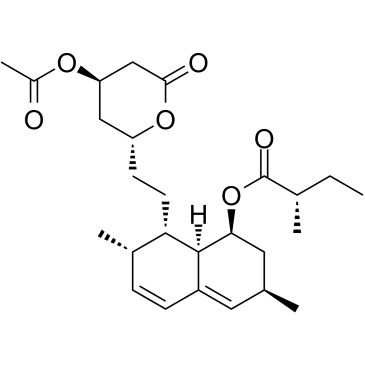Acetyllovastatin is the acetated form of Lovastatin acetate of Lovastatin, which is a statin drug for hyperlipidemia. It exhibits inhibitory effect against the enzyme acetylcholinesterase with an IC50 of 79 μg/mL. Lovastatin also shows antifungal activityAcetyllovastatin from Stephania tetrandra, such as (R)-Fangchinoline (Thalrugosine), have hypotensive and antimicrobial properties. Many plants in the genus Stephania have roots and stems that are used in traditional Chinese medicine to treat fever, diarrhea, dyspepsia, and urinary tract infections[1].
Physicochemical Properties
| Molecular Formula | C26H38O6 |
| Molecular Weight | 446.57600 |
| Exact Mass | 446.267 |
| CAS # | 81189-92-6 |
| PubChem CID | 90477402 |
| Appearance | Typically exists as solid at room temperature |
| LogP | 4.766 |
| Hydrogen Bond Donor Count | 0 |
| Hydrogen Bond Acceptor Count | 6 |
| Rotatable Bond Count | 9 |
| Heavy Atom Count | 32 |
| Complexity | 768 |
| Defined Atom Stereocenter Count | 8 |
| SMILES | O([C@H]1C[C@@H](C)C=C2C=C[C@@H]([C@@H]([C@@H]12)CC[C@H]1OC(=O)C[C@H](OC(=O)C)C1)C)C(=O)[C@@H](C)CC |
| InChi Key | OYNSFDWALRRTFU-QQVNEASTSA-N |
| InChi Code | InChI=1S/C26H38O6/c1-6-16(3)26(29)32-23-12-15(2)11-19-8-7-17(4)22(25(19)23)10-9-20-13-21(30-18(5)27)14-24(28)31-20/h7-8,11,15-17,20-23,25H,6,9-10,12-14H2,1-5H3/t15-,16-,17-,20+,21+,22-,23-,25-/m0/s1 |
| Chemical Name | [(1S,3R,7S,8S,8aR)-8-[2-[(2R,4R)-4-acetyloxy-6-oxooxan-2-yl]ethyl]-3,7-dimethyl-1,2,3,7,8,8a-hexahydronaphthalen-1-yl] (2S)-2-methylbutanoate |
| HS Tariff Code | 2934.99.9001 |
| Storage |
Powder-20°C 3 years 4°C 2 years In solvent -80°C 6 months -20°C 1 month |
| Shipping Condition | Room temperature (This product is stable at ambient temperature for a few days during ordinary shipping and time spent in Customs) |
Biological Activity
| Targets | The enzyme acetylcholinesterase(IC50= 79 μg/mL ) |
| References | [1]. Antimicrobial Butyrolactone I Derivatives from the Ecuadorian Soil Fungus Aspergillus terreus Thorn. var terreus. World Journal of Microbiology and Biotechnology, 2005,21(6-7), 1067–1075. |
Solubility Data
| Solubility (In Vitro) | DMSO : ≥ 250 mg/mL (~559.81 mM) |
| Solubility (In Vivo) |
Solubility in Formulation 1: ≥ 2.08 mg/mL (4.66 mM) (saturation unknown) in 10% DMSO + 40% PEG300 + 5% Tween80 + 45% Saline (add these co-solvents sequentially from left to right, and one by one), clear solution. For example, if 1 mL of working solution is to be prepared, you can add 100 μL of 20.8 mg/mL clear DMSO stock solution to 400 μL PEG300 and mix evenly; then add 50 μL Tween-80 to the above solution and mix evenly; then add 450 μL normal saline to adjust the volume to 1 mL. Preparation of saline: Dissolve 0.9 g of sodium chloride in 100 mL ddH₂ O to obtain a clear solution. Solubility in Formulation 2: ≥ 2.08 mg/mL (4.66 mM) (saturation unknown) in 10% DMSO + 90% Corn Oil (add these co-solvents sequentially from left to right, and one by one), clear solution. For example, if 1 mL of working solution is to be prepared, you can add 100 μL of 20.8 mg/mL clear DMSO stock solution to 900 μL of corn oil and mix evenly. (Please use freshly prepared in vivo formulations for optimal results.) |
| Preparing Stock Solutions | 1 mg | 5 mg | 10 mg | |
| 1 mM | 2.2392 mL | 11.1962 mL | 22.3924 mL | |
| 5 mM | 0.4478 mL | 2.2392 mL | 4.4785 mL | |
| 10 mM | 0.2239 mL | 1.1196 mL | 2.2392 mL |
